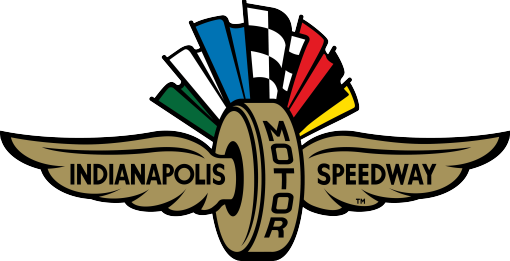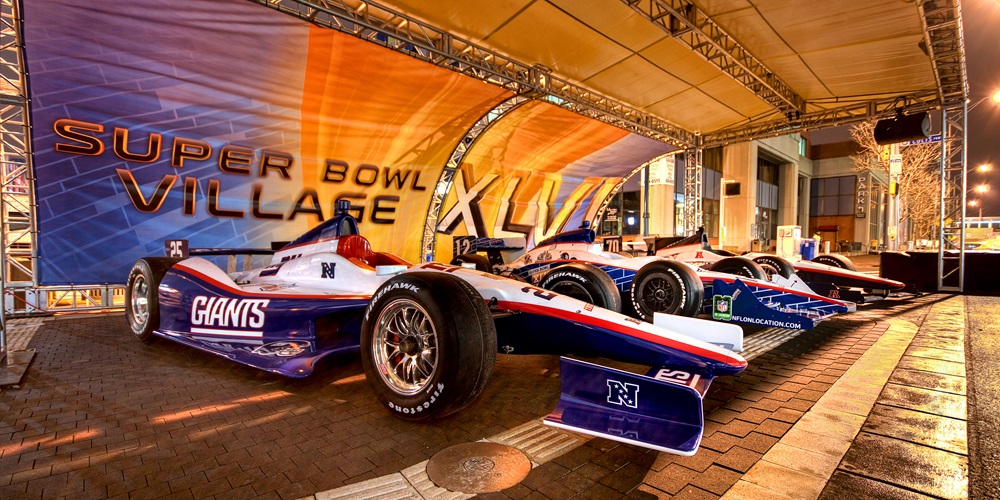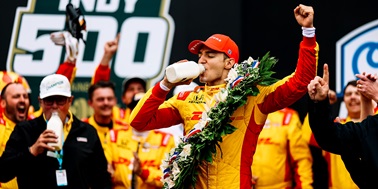A branded INDYCAR SERIES car displayed at Indianapolis International Airport. A 300-foot graphic of the Borg-Warner Trophy affixed to a towering, downtown-facing hotel. Murals as part of an arts-and-culture infusion woven into the event. Twenty-thousand people certified in super-service hospitality.
All part of annually celebrating the Indianapolis 500 presented by Gainbridge. All first on display at Super Bowl XLVI in 2012.
Ten years ago this week, Indianapolis’ Super Bowl Host Committee, led by current Penske Entertainment Corp. executives Mark Miles and Allison Melangton, showcased the city in a never-seen-before way. An image of the NFL’s Lombardi Trophy, presented to each Super Bowl champion, adorned the east side of the then-new JW Marriott hotel. INDYCAR SERIES cars were wrapped in designs honoring each of the 32 NFL teams, including the New York Giants and New England Patriots, who would play at Lucas Oil Stadium.
The committee initiated widespread student engagement and visits to all 92 of Indiana’s counties.
Sound familiar?
Four years later, after Miles and Melangton had taken new roles at INDYCAR and Indianapolis Motor Speedway, many of the elements that delivered Indianapolis to the Super Bowl’s global audience were applied to the 100th Running of the “500” in 2016. Today, many of the promotional pieces are standard not only for the “500” but also major sporting events in the city, such as the recently held College Football Playoff National Championship, Final Fours, even “Monday Night Football.”

The signature piece of Super Bowl planning came from what was described as “a crazy idea” from Susie Townsend, now Visit Indy’s senior vice president of visitor experience. From that call with Melangton came INDYCAR SERIES cars aligned in rows of three – Indy 500 style -- on South Meridian Street with the Super Bowl’s Roman numerals and the Soldiers & Sailors Monument serving as a backdrop.
Melangton remembers calling Scott Jasek, a co-owner of Indy Racing Experience, which owned a collection of Indy-style show cars, to make the request.
“I thought he was going to have a heart attack wondering where he was going to get that many cars,” Melangton said, laughing.
Rather, Jasek simply put the gears in motion and delivered. In all, the company located south of IMS wrapped 36 cars and designed a plan to transport them downtown for perfect alignment. The cars became the iconic image of Indy’s Super Bowl, and, of course, it wasn’t by accident.
Melangton, a native of Maine by way of Colorado State University, wasn’t the INDYCAR aficionado she is today, but she had lived in Indianapolis since 1983 and knew the sport was the city’s signature sight. Through ideas such as Townsend’s, Melangton sought to make INDYCAR SERIES cars the Super Bowl’s artwork.
“It was a conscious decision to include Indy cars because that’s what Indy is known for, and it was very effective,” Melangton said. “Everyone wanted their pictures taken with those cars, and we had them all over town.”
Said Jasek: “We had wrapped a few cars before for one-off (events), but nothing of that scale and never for another major sporting event. For that iconic photograph, we took the cars down in the middle of the night and staged them. It had snowed right before that, but it cleared enough for me to draw a chalk line to get the first row of cars lined up, because they had to be perfect, right? It took all night.”
Soon after, the cars were moved to new locations throughout the community. Three cars, including those representing the Giants and Patriots, went to Super Bowl Village. The airport got a few. Several more went to IMS, where they were suspended for the traditional Super Bowl Media Party, still regarded as the best such event in Super Bowl history.
Indianapolis’ Host Committee had drafted students to present copies of its Super Bowl bid to each NFL owner, and those individuals, like thousands of other people, got their photographs taken with the colorful cars.
“It was brilliant how those cars were used, and it opened the door to (showcasing IMS and INDYCAR) for all sorts of events,” Jasek said. “We did Alabama and Georgia cars for (last month’s) college football playoff, a show car for Georgia’s alumni event, and Honda has one in Las Vegas this weekend for the NHL All-Star Game.
“All of that is great publicity for the sport and the city.”
Melangton kept her binder of plans for the 100th Running of the “500” in 2016, but she doesn’t need to refer to it because much of those plans have become annual traditions, such as the drivers hanging downtown street signs bearing their names and the neighborhood porch parties.
The number of groups that come together each year to promote the “500” trace cooperation to the Super Bowl. IMS, INDYCAR, the 500 Festival, Visit Indy, Downtown Indy, the Harrison Center, the Indy Arts Council -- they know each other so well because of that shared experience a decade ago.
“The Super Bowl was a turning point where organizations in the city understood that all working together and lifting each other up together made us all stronger together,” she said.
Again, it wasn’t a coincidence that IMS was integrated into the planning of Super Bowl XLVI. Former IMS and INDYCAR CEO Tony George was a member of the Host Committee’s Board of Directors, a group chaired by Miles, now the president and CEO of Penske Entertainment, which owns those Indianapolis-based motorsports entities. The large group of residents that annually help stage “The Greatest Spectacle in Racing” helped form the Super Bowl’s massive volunteer base.
The magnitude of the city’s two events is what drew Melangton’s interest in becoming IMS’ senior vice president of events in 2014.
“Particularly the 100th Running,” she said. “It was a historic event for the city just like the Super Bowl was a historic event.
“It’s not often that Indianapolis gets in the global spotlight – the Super Bowl did that (in 2012) and the Indy 500 does that every year – and those of responsible for those events have to caretake the image of our city and our state with real responsibility.
“By making a huge splash through community décor, engagement and activation, you put Indianapolis on the map to compete with any other major city.”




